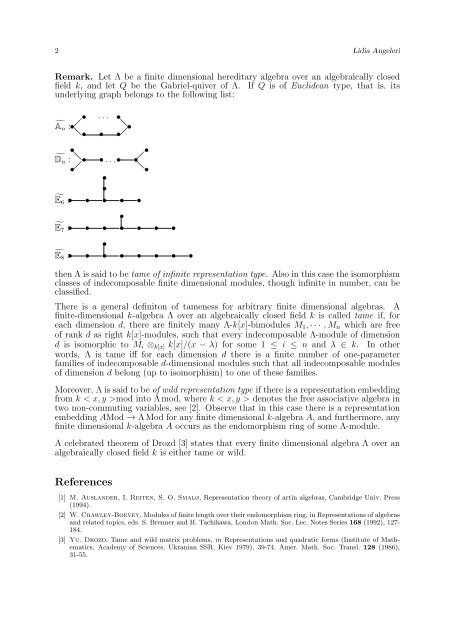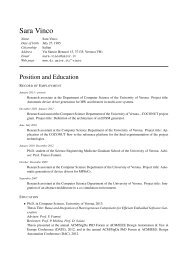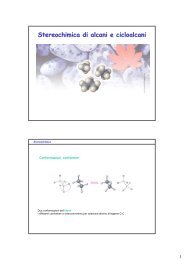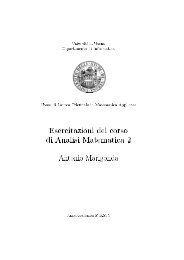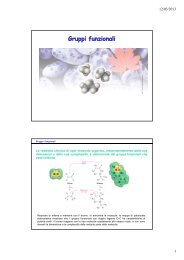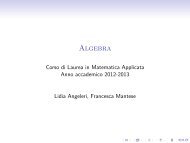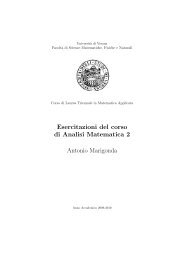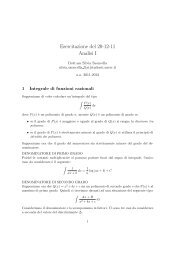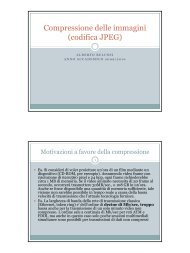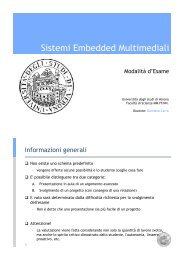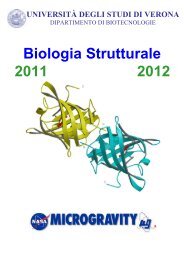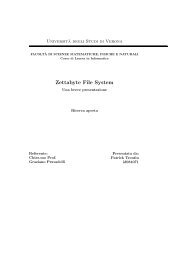Lidia Angeleri, Francesca Mantese Universit`a di Verona, 2010/11 ...
Lidia Angeleri, Francesca Mantese Universit`a di Verona, 2010/11 ...
Lidia Angeleri, Francesca Mantese Universit`a di Verona, 2010/11 ...
Create successful ePaper yourself
Turn your PDF publications into a flip-book with our unique Google optimized e-Paper software.
2 <strong>Li<strong>di</strong>a</strong> <strong>Angeleri</strong><br />
Remark. Let Λ be a finite <strong>di</strong>mensional here<strong>di</strong>tary algebra over an algebraically closed<br />
field k, and let Q be the Gabriel-quiver of Λ. If Q is of Euclidean type, that is, its<br />
underlying graph belongs to the following list:<br />
An : <br />
• . . . •<br />
• ❅•<br />
❅•<br />
• •<br />
•<br />
Dn : ❅•<br />
•<br />
• . . . •<br />
•<br />
•<br />
•<br />
•<br />
❅•<br />
E6 :• • • • •<br />
E7 :• • •<br />
•<br />
• • • •<br />
E8 :• •<br />
•<br />
• • • • • •<br />
then Λ is said to be tame of infinite representation type. Also in this case the isomorphism<br />
classes of indecomposable finite <strong>di</strong>mensional modules, though infinite in number, can be<br />
classified.<br />
There is a general definiton of tameness for arbitrary finite <strong>di</strong>mensional algebras. A<br />
finite-<strong>di</strong>mensional k-algebra Λ over an algebraically closed field k is called tame if, for<br />
each <strong>di</strong>mension d, there are finitely many Λ-k[x]-bimodules M1, · · · , Mn which are free<br />
of rank d as right k[x]-modules, such that every indecomposable Λ-module of <strong>di</strong>mension<br />
d is isomorphic to Mi ⊗k[x] k[x]/(x − λ) for some 1 ≤ i ≤ n and λ ∈ k. In other<br />
words, Λ is tame iff for each <strong>di</strong>mension d there is a finite number of one-parameter<br />
families of indecomposable d-<strong>di</strong>mensional modules such that all indecomposable modules<br />
of <strong>di</strong>mension d belong (up to isomorphism) to one of these families.<br />
Moreover, Λ is said to be of wild representation type if there is a representation embed<strong>di</strong>ng<br />
from k < x, y >mod into Λ mod, where k < x, y > denotes the free associative algebra in<br />
two non-commuting variables, see [2]. Observe that in this case there is a representation<br />
embed<strong>di</strong>ng AMod → Λ Mod for any finite <strong>di</strong>mensional k-algebra A, and furthermore, any<br />
finite <strong>di</strong>mensional k-algebra A occurs as the endomorphism ring of some Λ-module.<br />
A celebrated theorem of Drozd [3] states that every finite <strong>di</strong>mensional algebra Λ over an<br />
algebraically closed field k is either tame or wild.<br />
References<br />
[1] M. Auslander, I. Reiten, S. O. Smalø, Representation theory of artin algebras, Cambridge Univ. Press<br />
(1994).<br />
[2] W. Crawley-Boevey, Modules of finite length over their endomorphism ring, in Representations of algebras<br />
and related topics, eds. S. Brenner and H. Tachikawa, London Math. Soc. Lec. Notes Series 168 (1992), 127-<br />
184.<br />
[3] Yu. Drozd, Tame and wild matrix problems, in Representations and quadratic forms (Institute of Mathematics,<br />
Academy of Sciences, Ukranian SSR, Kiev 1979), 39-74. Amer. Math. Soc. Transl. 128 (1986),<br />
31-55.


